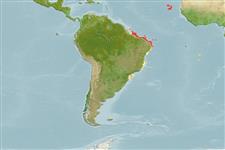Common names from other countries
>
Eupercaria/misc (Various families in series Eupercaria) >
Labridae (Wrasses) > Bodianinae
Etymology: Bodianus: Bodianus after Bodiano or Pudiano, from the Portuguese pudor, meaning modesty (Jordan & Evermann, 1896).; insularis: Name derived from a Latin adjective meaning 'of an island'; in reference to the apparent restriction of this species to islands associated with the Mid-Atlantic Ridge (Ref. 75973).
Environment: milieu / climate zone / depth range / distribution range
Écologie
marin récifal; profondeur 6 - 60 m (Ref. 58047). Tropical
Eastern Atlantic: St. Paul Rocks, Ascension and St. Helena.
Taille / Poids / Âge
Maturity: Lm ? range ? - ? cm
Max length : 33.0 cm TL mâle / non sexé; (Ref. 3637)
Caught in areas of rock and rubble bottoms associated with sand or reef-like areas. Protogynous hermaphrodite, with obvious sexual dichromatism (Ref. 5292). Oviparous, distinct pairing during breeding (Ref. 205). Juveniles remove ectoparasites from other species (Ref. 86997).
Life cycle and mating behavior
Maturities | Reproduction | Spawnings | Egg(s) | Fecundities | Larves
Oviparous, distinct pairing during breeding (Ref. 205).
Gomon, M.F., 1981. Labridae. In W. Fischer, G. Bianchi and W.B. Scott (eds.) FAO species identification sheets for fishery purposes. Eastern Central Atlantic; fishing areas 34, 47 (in part). Department of Fisheries and Oceans Canada and FAO. Vol. 2. pag. var. (Ref. 3637)
Statut dans la liste rouge de l'IUCN (Ref. 130435)
CITES (Ref. 128078)
Not Evaluated
Menace pour l'homme
Harmless
Utilisations par l'homme
Pêcheries: intérêt commercial mineur
Outils
Articles particuliers
Télécharger en XML
Sources Internet
Estimates based on models
Preferred temperature (Ref.
115969): 26.1 - 27.6, mean 27.4 (based on 42 cells).
Phylogenetic diversity index (Ref.
82804): PD
50 = 0.5000 [Uniqueness, from 0.5 = low to 2.0 = high].
Bayesian length-weight: a=0.01202 (0.00551 - 0.02625), b=3.05 (2.87 - 3.23), in cm Total Length, based on LWR estimates for this Genus-body shape (Ref.
93245).
Niveau trophique (Ref.
69278): 3.5 ±0.5 se; based on size and trophs of closest relatives
Résilience (Ref.
120179): Milieu, temps minimum de doublement de population : 1,4 à 4,4 années (Preliminary K or Fecundity.).
Fishing Vulnerability (Ref.
59153): Low vulnerability (23 of 100).
